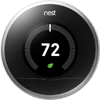Making your home more energy efficient can be as simple as installing a programmable thermostat. There are many models on the market, so it’s important to be informed before buying one to ensure it fits your home’s needs.
The Buzz About the Nest
One brand that’s getting a lot of buzz is the Nest thermostat. Here’s what it’s reputed to do:
 Nest takes programmable thermostats to a new level, according to the product’s website: it learns your heating and cooling habits after a few days, and then automatically adapts to those preferences to help you save energy.
Nest takes programmable thermostats to a new level, according to the product’s website: it learns your heating and cooling habits after a few days, and then automatically adapts to those preferences to help you save energy.- Most people change the thermostat when they wake up, but Nest offers a an “Early-On” function touted to allow you to wake up to the exact temperature you want at the exact time you want.
- Nest works in sync with the type of air system you have in your home, whether it’s forced air or radiant heat.
- Some programmable thermostats flash or beep to remind you to change your air filter every 30 days. The Nest smart thermostat, however, gauges the condition of your air filter based on how you use your heating and cooling system — which may mean you could wait another month before changing your filter.
- There’s an “Auto-Away” function, that according to the website, can activate as quickly as 30 minutes after you’ve left.
- There’s an app for that! The Nest mobile app allows you to control up to 10 thermostats between two homes. Nest is compatible with most smartphones and tablets.
Consumers Put Nest to the Test
 Consumer Reports considers the Nest an innovator in its space, yet it doesn’t give this smart thermostat the top rating among other remote access models. According to Consumer Reports, the Nest’s greatest asset is its sleek display. That doesn’t mean it’s not easy to use. In fact, many users tout what a breeze it was to install their Nest, as well as the convenience and ease of controlling the unit remotely.
Consumer Reports considers the Nest an innovator in its space, yet it doesn’t give this smart thermostat the top rating among other remote access models. According to Consumer Reports, the Nest’s greatest asset is its sleek display. That doesn’t mean it’s not easy to use. In fact, many users tout what a breeze it was to install their Nest, as well as the convenience and ease of controlling the unit remotely.
Some hang-ups mentioned in user reviews include a shaky WiFi connection and a faulty backplate, which can inadvertently run your A/C at the same time as your heat.
A Cnet.com editor took the Nest for a spin in his own home and found the Auto-Away and remote access features to be his favorite features. Again, set-up was considered as simple as installing a light fixture. However, the Cnet.com editor did mention that the Nest was not designed to sync perfectly with his 60-year-old home. Older wiring can be problematic even for the newest Nest model.
Another potential drawback for potential Nest users is the investment, at approximately $250 per unit. Homes with significant square footage may require multiple units, causing a larger upfront purchase and a longer wait for savings to offset the price tag.
The Bottom Line
 The Nest thermostat is one example of the increase in popularity of smart technology in programmable thermostats. With nearly half of your monthly energy bills coming from heating and cooling, there’s great potential to save money with these types of devices. The Nest may be one option worth your consideration.
The Nest thermostat is one example of the increase in popularity of smart technology in programmable thermostats. With nearly half of your monthly energy bills coming from heating and cooling, there’s great potential to save money with these types of devices. The Nest may be one option worth your consideration.
Photo Credit: Nest Thermostat
See Also: 5 Ways to Reduce Your Air Conditioning Bill – Now!




